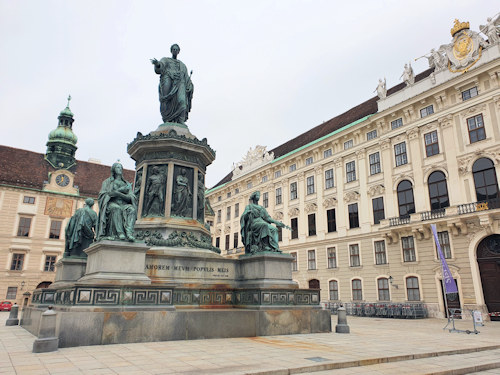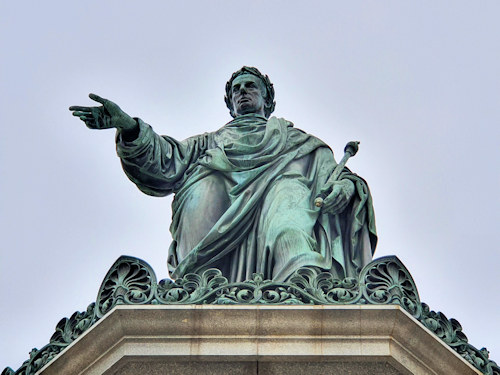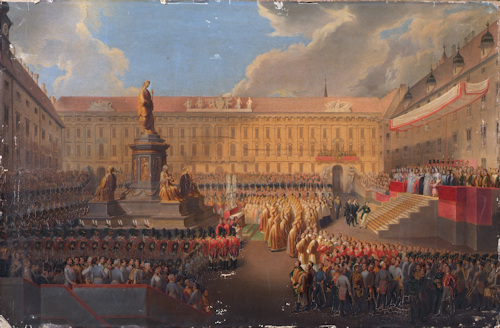
Wander through the courtyards of the Hofburg palace area in central Vienna and only one major monument catches the eye: an 1846 statue of the man notable for being emperor of two entirely different empires.
- Statue of Franz II/I, who ruled from 1792 to 1835
- Erected in 1846 by Emperor Ferdinand I
- Bronze work designed by Pompeo Marchesi
- Monument includes several symbolic figures and reliefs
- Book a guided tour* of the Hofburg area
- See also:
The Franz II/I statue

(View across the Innere Burghof courtyard)
Following the death of Leopold II in 1792, the position of Holy Roman Emperor was soon given to his son, Franz (1768-1835). The young Habsburg monarch thus became Emperor Franz II.
It seems you can never have quite enough empires, though. In 1804, Franz also established the Austrian Empire, thus becoming its first emperor and assuming a second imperial title (Franz I).
Things got a little easier in 1806 when the Holy Roman Empire dissolved, allowing Emperor Franz II/I to become just Emperor Franz I (saving everyone a lot of tedious explanations at cocktail parties).
Franz’s reign did not pass without incident. For example, he crossed swords regularly with Napoleon, hosted the seminal Congress of Vienna, and his politics caused the Biedermeier cultural phenomenon.
After Franz died, his son and successor (Ferdinand I) decided to erect a monument to his father.
The contract for the proposed installation went to the sculptor Pompeo Marchesi with the official unveiling in June, 1846.

(The emperor himself)
Franz himself stands on top, dressed in Roman garb to evoke that classical imperial aura. The column below has a set of reliefs symbolising various activities pursued by the empire’s subjects, such as commerce and industry, mining, farming, art, and science.
Four female statues sit at corners below Franz, representing faith, strength, justice and peace, and two Latin inscriptions complete the work:
- The shorter inscription quotes part of Franz’s will; Amorem meum populis meis means something like “my love for my people(s)”.
- The longer one offers an effusive dedication to Franz and gives the year of the monument’s completion.
The statue sits in the Innerer Burghof courtyard within the great Hofburg palace complex at Vienna’s centre. Franz more or less faces the famous Schweizertor Renaissance gateway.
The unveiling in the presence of Ferdinand and the imperial family proved quite an occasion. They even renamed the courtyard in Franz’s honour on the same day; the Franzensplatz name did not survive the end of the monarchy, though.

(Painting by Leopold Bucher of the unveiling on June 16th, 1846. A small affair, as you can tell. Photo courtesy of and © Belvedere, Wien. Reproduced with permission under the terms of Creative Commons License CC BY-SA 4.0.)
Guests, onlookers, and military guards filled the courtyard and surrounding vantage points. One window remained shuttered, however: the former room of Franz himself.
As one paper put it (my rough translation):
Everything was drowned out by the jubilation that broke out among the assembled crowd on seeing the unforgettable features of the universally loved monarch. This homage, these tears of deepfelt emotion that glistened in all eyes paid noble witness to the deep love and veneration always held by the people toward the deceased and which continues even as he lies in his grave.
(Possibly not an entirely unbiased report.)
How to get to Franz I
Either start at Michaelerplatz and walk through under the dome to emerge in the right courtyard. Or find your way to the Äußeres Burgtor, then follow the road between the two equestrian statues across Heldenplatz square and through the arched entranceways into the Hofburg.
You likely pass the Franz monument on any walk through the local area. And, incidentally, you can also spot it in Season 3 of the period detective drama, Vienna Blood.
Address: Innerer Burghof, Hofburg, 1010 Vienna